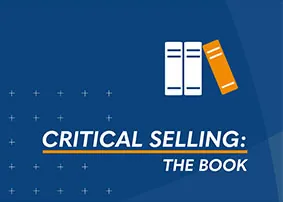Understanding and Handling Apathetic Customers

What is an apathetic customer? Dictionary.com defines apathy as absence or suppression of passion, emotion, or excitement. What apathy is not, is an objection. Therefore, salespeople should quit treating it as such.
In the resting phase of the buying lifecycle, you’re going to run up against the apathetic customer. That’s someone who is fully or partially satisfied with their current business solution and doesn’t have the mental bandwidth for seeing the value a salesperson is proposing. Ms. or Mr. Apathy’s impulsive response to a sales overture goes something like, “Not interested,” or “We’re all set,” or “We already have a solution in place. See ya!”
This will be especially the case with new leads and prospects. With existing customers, you’ll sometimes arrive at a dead-end response when you go down the road of discussing new products and ideas you think could grow their business.
Stop Trying to Prove a Point or Jump into a Pitch
The biggest pitfall a sales person can make when encountering apathetic customers is to try to prove a point or jump into a pitch about why the customer really needs to onboard with their product or service. Here’s why that’s a bad idea: Even if you’re peddling dinghies in a flood, the customer has already said, “I don’t have a need for that.” If your response is to try to convince them that they do need it, you’ll never get to the buying phase, or even close to it: The customer has already decided they don’t want to talk to you.
Establish That You Understand the Customer is Happy and Satisfied
When you hear “not interested,” cut through the tension by establishing that you get that the customer is happy and satisfied with the product or service they’re currently using. Then make the case that your aim is to have a conversation with them to determine if your offering is a better solution or if it could supplement what they already have in place.
It behooves you not to try to hard-sell the apathy-ridden; instead get them to keep the door ajar and have a conversation with you—no commitments, no regrets. Remember, at this stage in the buying lifecycle, they haven’t butterflied into a full-grown purchaser yet.
Get The Customer to the Conversation Phase
In other words, brave sales rep, it’s all cocoons for now. Put down the butterfly net and forget selling for a moment—what you need to do is earn the customer’s trust enough to get them to buy into talking to you. Once you’ve overcome that customer hurdle, you can ask questions that lead them toward the light of awareness that they actually might need your products or services. It’s an organic process: The customer with the mindset of “Go away; I don’t want that” will have to flap their own wings toward the awareness that they might have a hole you can fill. This isn’t the time to sell, because it’s very likely that the customer isn’t ready to buy. Your role is to get them to the conversation phase and let their minds do the rest—in the meantime, you need to relax and give the hard sales pitch a rest.
Things Sales Professionals Should Never Do When Responding to Apathetic Customers
Handling apathetic customers can be one of the most challenging situations a sales professional deals with. Before we get into the “don’ts” for handling apathy, let’s first define what apathy sounds like. Below are just a few of the types of statements you might encounter from apathetic customers:
- “We’re already working with someone else.”
- “We’re happy with our current vendor.”
- “I don’t really have time to get into this right now.”
- “The timing isn’t good for us right now.”
- “We are all set for now.”
So when looking at these statements, what is the customer really conveying? An apathetic customer is defined as a customer who appears indifferent to your product or service. Sales professionals most commonly encounter apathy from customers during the prospecting process while trying to engage a new customer in a conversation.
From our research here at Janek, we have determined three things that a sales professionals should never do when responding to apathetic customers.
Do not transition from a customer’s apathetic statement
such as “I’m not interested at this time,” or “We already have something like this in place,” into a scripted sales pitch. Recognize such statements from customers for what they are: a way to distract you and end the conversation. Therefore, the last thing that you want to do is go into a long sales pitch. This will only result in pushing the customer further away. At this point, you begin to sound like a typical salesperson, and the prospective customer will simply tune you out.
Do not knock their current situation.
This type of approach can be common in industries in which you may already be familiar with who they are working with. When you begin to knock their current provider without establishing any sort of credibility or relationship, you appear as sounding unprofessional and desperate. You also insinuate that they made a bad decision by going with that company in the first place. When you are trying to establish a connection with a potential new customer, you certainly do not want to insult him or her.
Never push too hard for time when the customer obviously sounds or looks extremely busy
Admittedly, this can be a fine line, as the customer may simply be trying to blow you off. If the customer still sounds busy after you have attempted to overcome his or her apathetic position, it may be better to express concern for the customer’s time and then attempt to schedule a follow-up appointment.
Apathy can be a tough situation without the right sales training. Prospecting techniques such as those covered in our Critical Prospecting Skills program focus on these challenging situations and provide the tools necessary to turn an apathetic customer, into a prospect.
Sales Techniques for Handling Apathy in Customers
We’ve all heard responses like, “I’m not interested,” or “I don’t need that,” or “I have something similar that works just fine.” These vague responses signal an apathetic customer or prospect; one who doesn’t give you much with which to work. In reality, he or she is just not engaged or prepared to consider what your company has to offer.
Unfortunately, many sales reps will hear thesee perceived blow-offs and immediately click into “overcoming objection” mode. They start selling the wonderful benefits of their product—not realizing that their fantastic sales spiel is falling on deaf ears. The reason for this reaction is that you and your prospect are not operating at the same stage of the sales process. You just leaped five steps ahead of your customer and even worse, may have just raised the prospect’s defense level in an already defensive dialogue.
The remedy? You guessed it. Create an awareness of needs. Let’s take a brief look at the steps to accomplish this.
1. Start with empathy
Try to soften your approach so that you lower the prospect’s defenses with replies such as, “I understand you are very busy…” Exhibiting this sort of empathy encourages your prospect to be less confrontational and more open with you. Understanding their position and attempting to keep the dialogue flowing is your goal at this stage.
2. Earn the right to continue
You must gain permission to move forward and to explore their need for what you have to offer. At this point you can begin gaining insight as to the prospect’s business and needs. Pique their interest with some of the benefits of continuing on in the conversation. Use a sentiment like, “We’ve worked with many companies like yours and have provided a strong return on investment with very little time needed. It certainly can’t hurt to spend just a few minutes speaking with me.” Remember, this is where you are letting the prospect know what’s in it for them to spend some time with you, even if they weren’t expecting to hear from you.
3. Assess the climate
Once you earn the right to continue on in the dialogue, begin to ask probing questions to understand first how they operate, who they use, etc. Once you understand those points, ask questions to get an understanding of how well those operations are performing e.g. what’s good or what’s bad with their current product or situation. Make sure your questions are fact or need-based. It is imperative that you fully understand their current situation.
4. Confirm Needs
As you are assessing the climate, you are naturally progressing into the identification of needs. Again, this isn’t the time to launch into your sales pitch. Think of this of this stage as a consultation, as if you are a doctor who is gathering patient information about symptoms, behavior, and past history. Ask them to tell you where it hurts. Once you can confirm their “pain points,” you can proceed with the next stage of the sales process, which is asking for the appointment to further identify solutions.
By using these steps with apathetic or uninterested customers, you will generate dialogue, create awareness of needs and ultimately generate more opportunities to sell your products and services. Instead of viewing the door as almost closed, view it as cracked open.
How to Turn Apathetic Customers Into Invested Ones
“Not interested.” “We’re happy with what we have now.” “I don’t have time.” We’ve all heard those rebuffs that sit in the middle of the sales/prospecting road – giant obstacles that block us from proceeding further. They’re not even objections that we can work with – they’re stonewalls that signal a refusal to engage. Unanswered emails and LinkedIn messages fall under this heading, too.
This disconnect just doesn’t apply to prospects – it’s part of your current customers, too. Gallup found that just 29% of B2B customers are engaged with their vendors, and an overwhelming 71% are either indifferent or disengaged. Engagement is critical – as that Gallup report notes, engaged customers translate into 34% increase in profitability.
1. Find out what their problems are and use them as your lead-in
When you’re dealing with an indifferent prospect, find out their needs or problems. Ideally, this would involve you having a dialogue with them in a discovery process. In asking for the meeting, don’t center the conversation around your product or service. Stress that you just want to talk about what potential issues they’re having. In the hopefully ensuing discourse, again refrain from mentioning what you’re selling – this is strictly a fact-finding mission to get the lead thinking consciously about these issues and if no needs exist, that is perfectly okay.If their apathy is so deep-set that they’re not willing to even talk about problems, dig more into research. Monitor the social media accounts, news reports, financial filings (if a publicly held company), etc. to see if you can spot relevant issues from there.Another way of approaching hardened skepticism is to openly acknowledge it. Saying “I know you’re skeptical” or have doubts or whatever phrasing you decide to use won’t suddenly make the prospect wary – they already are. And that kind of open honesty and transparency can be refreshing to a prospect who is used to dealing with less ethical or more grasping sales reps.No matter which path you take to discovery, don’t follow up immediately. Instead, wait a few weeks. There’s no need to worry about being pipped here – after all, if they’re not talking to you, it’s a near-certainty they’re not talking to anybody. Then, after an appropriate amount of time has passed, follow up with something like the following: “Hi Prospect, After our discussion (or I noticed that – if your avenue was via research), I spent some time thinking about X problem. There’s a possibility that Y Product could be a solution. Would you be interested in setting up a time to explore this further? If so, I have Tuesday next week at 3 pm or Thursday at 9 am available. Let me know.”
Notice how this example positions the problem first and foremost. Also, this isn’t guaranteeing your product is a solution – merely that there’s a chance it could be and you want to explore further . And the follow-up conversation is more qualifying and discovery to answer the question of it’d be a fit. Note: You won’t be pitching during the follow-up meeting, either. It’s giving both sides more to think about, and as much work as it’s taken to dislodge the apathetic roots, it can be undone swiftly by a slip into selling mode.
2. Maintain contact, but keep it light, relevant, and remotely removed from the buying and selling process
If you can’t get the problems conversation going and can’t find anything from your research, then shift into pure relationship building mode. Still monitor the prospect and send them periodic emails with relevant links or congratulations (for example, a congratulatory email for opening a new location).This no-pressure approach will keep you on the top of the prospect’s mind and help to build trust because you’re not trying to convince them to take a meeting or sending signals that you want to eventually sell them something. You’re just focused on the relationship.
3. Touch base to see how things are going
When you have silence from a current client, that’s a detachment that might leave you vulnerable to losing the contract to more immediate and present vendors. Following up periodically with the client will not only keep you in their mind and strengthen the relationship, it can allow you to spot potential problems before they arise, or at least resolve them in the early stages before they metastasize into major issues.To reiterate, be sure touching base includes sharing information or a line of inquiry (such as monitoring how the product experience is going) that’s relevant and, most importantly, valuable to the client. Many customers will be turned off by a reaching out just to reach out and it could unexpectedly backfire into a worsening of the relationship.
Consider changing the account manager
While you may have won the initial contract with a specific rep and group of decision makers, the point of contact at the company might have changed, and so might the rep covering the account. Or it’s possible the initial relationship might have soured for whatever reason. In all these cases, it might be best to switch out reps for one who is better able to communicate with the client or who has a better personality fit for the client/point of contact persona.
Don’t Be Afraid to Address Apathy in Your Customers Head On
Apathy can be a dealbreaker for both prospects and currently contracted clients. It’s a silent, insidious contagion that can sometimes catch sales teams offguard. Careful attention to the relationship and deliberate steps to address the root issues, as outlined above, can resolve the problems and bring new energy to discussions.
Updated 6/9/2025
- Stop Trying to Prove a Point or Jump into a Pitch
- Establish That You Understand the Customer is Happy and Satisfied
- Get The Customer to the Conversation Phase
- Things Sales Professionals Should Never Do When Responding to Apathetic Customers
- Do not transition from a customer’s apathetic statement
- Do not knock their current situation.
- Never push too hard for time when the customer obviously sounds or looks extremely busy
- 1. Start with empathy
- 2. Earn the right to continue
- 3. Assess the climate
- 4. Confirm Needs
- 1. Find out what their problems are and use them as your lead-in
- 2. Maintain contact, but keep it light, relevant, and remotely removed from the buying and selling process
- 3. Touch base to see how things are going
- Consider changing the account manager
- Don’t Be Afraid to Address Apathy in Your Customers Head On

- Account Planning (11)
- Awards (50)
- Client Testimonial (37)
- Personal Branding (19)
- Podcast (11)
- Research (68)
- Sales Career Development (85)
- Sales Coaching (153)
- Sales Consulting (133)
- Sales Culture (164)
- Sales Enablement (340)
- Sales Leadership (108)
- Sales Management (242)
- Sales Negotiation (16)
- Sales Prospecting (124)
- Sales Role-Playing (18)
- Sales Training (229)
- Selling Strategies (255)
- Soft Skills (67)
- Talent Management (92)
- Trusted Advisor (27)
- Virtual Selling (41)
- Webinar (10)




























